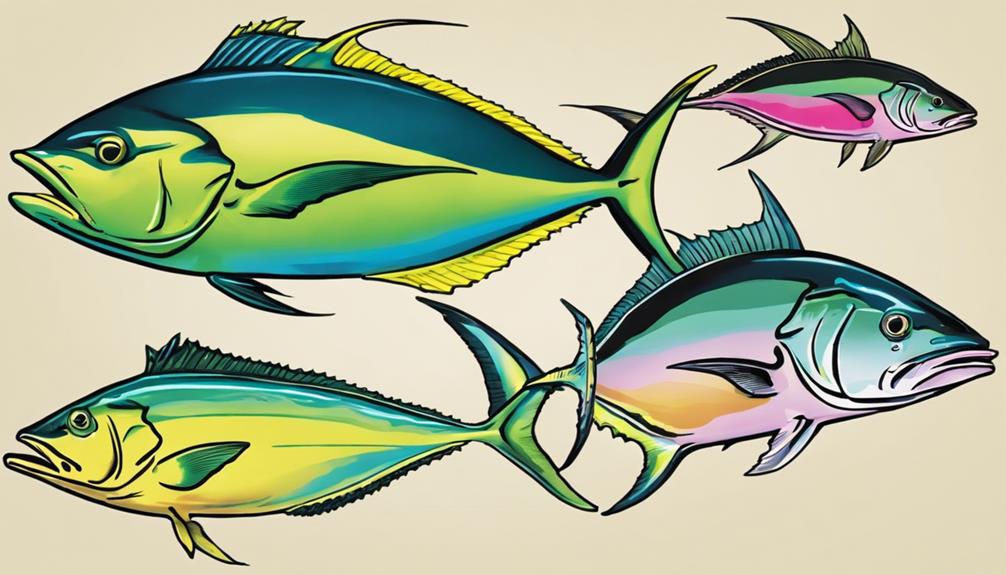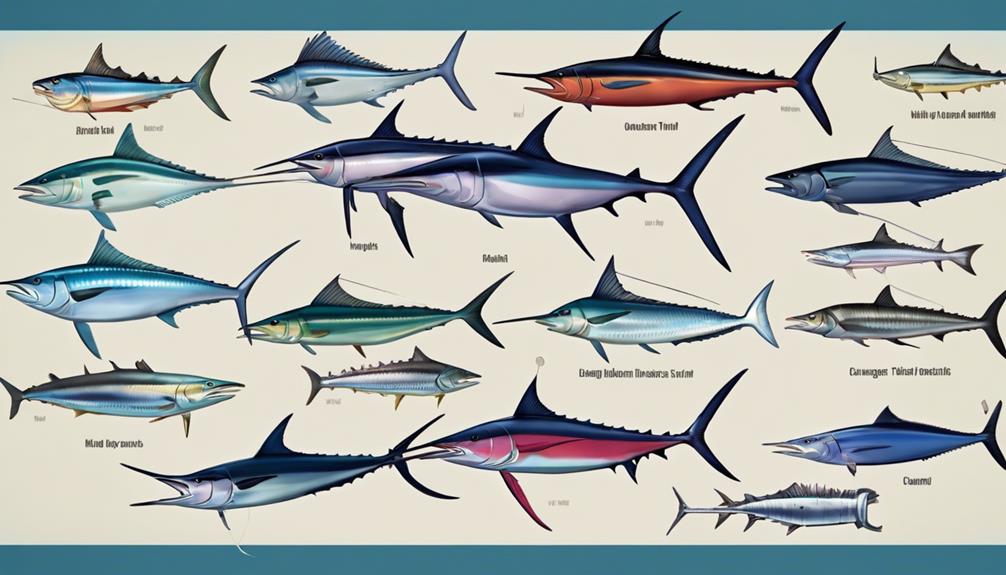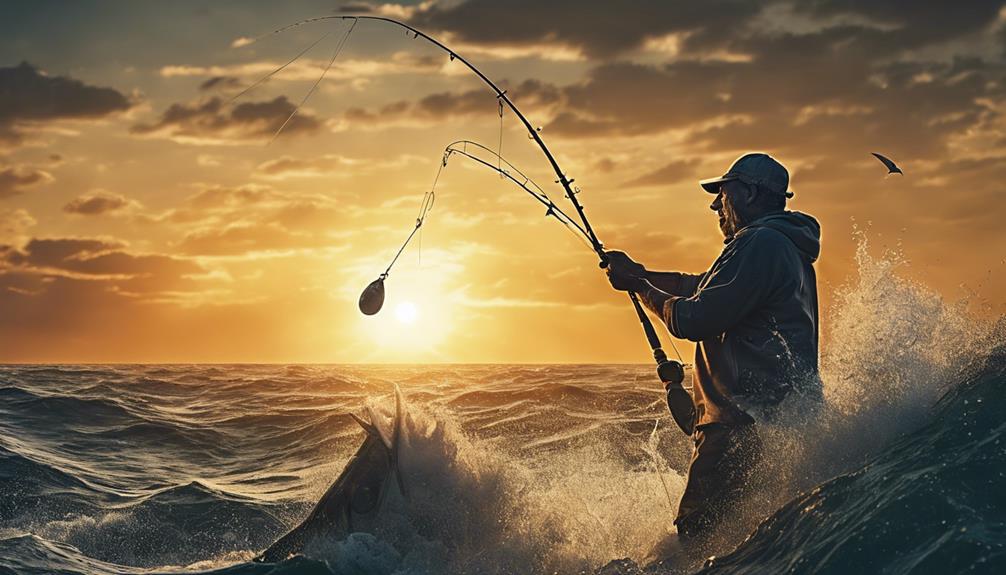When you're out on the open sea and reel in a catch that you're not quite sure about, wouldn't it be helpful to be able to confidently identify it? Understanding the nuances of deep-sea fish species can be a rewarding challenge.
By learning to distinguish fish through their color patterns, fin shapes, and unique physical features, you can elevate your fishing experience to a whole new level. But that's just the beginning – there are even more tips waiting to be explored to enhance your deep-sea fishing adventures.
Understanding Deep Sea Fish Anatomy
Have you ever wondered how the anatomy of deep-sea fish enables them to thrive in their extreme environment?
Deep-sea fish have unique adaptations that allow them to survive in the dark, high-pressure world of the ocean depths. One key feature of their anatomy is their specialized fish scales. These scales are often thin and delicate, providing minimal friction as the fish moves through the water. Unlike the scales of shallow-water fish, deep-sea fish scales aren't as colorful or reflective since there's limited light in their habitat. Additionally, some deep-sea fish have scales that contain light-producing cells called photophores, which help them camouflage or communicate in the dark depths.
Another crucial aspect of deep-sea fish anatomy is their jaw structure. Many deep-sea fish have hinged jaws that allow them to consume prey much larger than themselves. The structure of their jaws enables them to open wide and swallow prey whole, making it easier to capture food in the vast and sparsely populated deep-sea environment. Additionally, some deep-sea fish have sharp, fang-like teeth adapted for grasping and holding onto slippery prey in the dark waters.
Understanding the unique anatomy of deep-sea fish, including their specialized scales and jaw structures, provides insight into how these fascinating creatures have evolved to thrive in one of the most extreme environments on Earth.
Identifying Fish by Color Patterns
Exploring the distinct color patterns of deep-sea fish can aid in their identification and understanding their unique adaptations for survival in the ocean depths. Deep-sea fish have evolved a variety of color variations and camouflage techniques to thrive in their dark and often murky environments.
Here are some key points to help you identify deep-sea fish by their color patterns:
- Color Variations: Deep-sea fish exhibit a wide range of colors, including shades of black, red, silver, and blue. These colors can help them blend into their surroundings, making them less visible to predators or prey.
- Camouflage: Some deep-sea fish have developed intricate camouflage patterns that mimic the dappled light filtering down from the surface. This camouflage can help them avoid detection by predators lurking above.
- Distinctive Markings: Many deep-sea fish have distinctive markings such as stripes, spots, or patterns that are unique to their species. These markings can serve as visual cues for species recognition.
- Coloration: The overall coloration of a deep-sea fish, whether it's dark to blend with the deep sea or bioluminescent to lure prey, can provide insights into its behavior and ecological role in the deep-sea ecosystem.
Examining Fin Shapes and Sizes
When identifying deep-sea fishing species, examining the shapes and sizes of their fins can provide valuable insights into their behavior and habitat preferences. Comparing fin structures is a key aspect of this process. Different species have distinct fin shapes, sizes, and placements that are adapted to their specific environments and swimming behaviors. For example, species that dwell in open waters may have long, sleek fins for efficient propulsion, while those that navigate through rocky crevices might've shorter, more robust fins for precise maneuvering.
Analyzing tail shapes is another crucial factor in identifying deep-sea fishing species. The tail, or caudal fin, plays a vital role in propulsion and steering. Tuna, for instance, are known for their crescent-shaped tail fins that enable rapid acceleration and sustained swimming speeds. In contrast, species like groupers may have fan-shaped tail fins that provide powerful bursts of movement in short distances, ideal for ambushing prey in reef ecosystems.
Noting Unique Physical Features
Noticing distinctive physical attributes plays a crucial role in pinpointing and categorizing deep-sea fishing species. When trying to identify deep-sea species, paying attention to unique physical features can be a game-changer. Here are some key features to look out for:
- Scale Patterns: Examining the scale patterns on a fish's body can provide valuable insights into its species. Some species have distinct scale patterns that can be used as a distinguishing factor. Take note of the size, shape, and arrangement of scales to help narrow down your identification.
- Eye Shapes: The shape and size of a fish's eyes can vary significantly between species. Some deep-sea fish have evolved specific eye shapes that suit their hunting or survival strategies. By observing the eyes closely, you may be able to match them to known species in identification guides.
- Genetic Testing: In cases where visual identification is challenging, genetic testing can be a powerful tool. By analyzing the genetic makeup of a fish, scientists can accurately determine its species. While this method may not be readily available to all, it's incredibly accurate in species identification.
- Underwater Photography: Underwater photography can capture details that might be challenging to observe in live fish. High-quality images can help you zoom in on specific physical features for later analysis and comparison with identification resources. Consider investing in a good underwater camera to aid in your deep-sea fishing species identification efforts.
Using Fish Behavior as Clues
Observing fish behavior can provide valuable clues in identifying deep-sea fishing species. By studying movements and analyzing feeding habits, you can enhance your ability to recognize different types of fish when out on the water. Pay attention to how the fish swim, feed, and interact with each other, as these behaviors can be distinctive to certain species.
For example, if you notice a group of fish swimming rapidly near the surface and aggressively feeding on smaller fish, you might be observing a school of tuna. Tunas are known for their fast swimming speeds and voracious appetites, making them stand out from other species that may swim more slowly or feed on different prey.
On the other hand, if you see a fish hovering near the ocean floor, picking at small crustaceans or bottom-dwelling creatures, you could be looking at a grouper. Groupers tend to be opportunistic feeders, taking advantage of easy meals near the seabed. Their behavior contrasts with that of fish like mackerel, which are known for their swift movements through the water column in pursuit of schools of smaller fish.
Consultation With Local Experts
Engage with local experts to gain valuable insights into identifying deep-sea fishing species effectively. These individuals possess a wealth of knowledge about the marine life in your specific area, making them invaluable resources for honing your species identification skills. When consulting with local experts, consider the following:
- Species Characteristics: Local experts can provide detailed information on the physical characteristics and behaviors of different deep-sea fishing species. They can guide you on how to distinguish between similar-looking species based on specific features such as fin shapes, color patterns, and sizes.
- Habitat Knowledge: Understanding the habitats where specific species are commonly found is crucial for accurate identification. Local experts can share information about the preferred environments of different deep-sea fishing species, including details about depth ranges, water temperatures, and types of seabeds.
- Migration Patterns: Local experts can educate you on the seasonal migration patterns of various deep-sea fishing species. Knowing when certain species are more likely to be present in your fishing area can help you anticipate what you might encounter during different times of the year.
- Regulations and Conservation: Local experts can also inform you about regulations regarding certain species, including size limits, catch quotas, and protected species. Their insights can help you fish responsibly and contribute to the conservation of marine biodiversity.
Learning About Common Misidentifications

To enhance your deep-sea fishing species identification skills, familiarize yourself with common misidentifications that can occur while out on the water. Misidentification risks are prevalent, especially when species share similar physical characteristics or when environmental conditions affect their appearance.
One common misidentification is between the yellowfin tuna and the bigeye tuna, as both have sleek bodies and yellow fins. However, the bigeye tuna has larger eyes compared to the yellowfin tuna, which is a key distinguishing feature for accurate species recognition.
Another misidentification risk is between the mahi-mahi and the rainbow runner. Both species have vibrant colors and long bodies, making it easy to confuse them. The key difference lies in the shape of their dorsal fins; the mahi-mahi has a more curved dorsal fin compared to the straighter dorsal fin of the rainbow runner.
Additionally, understanding the nuances in features such as fin shapes, color patterns, and size can greatly aid in avoiding misidentifications while deep-sea fishing.
Employing Field Guides and Apps
Utilize field guides and apps to aid in accurately identifying deep-sea fishing species while out on the water. Technology tools have revolutionized the way anglers can identify species with just a few taps on their smartphones or tablets. Here's how you can make the most of these resources:
- Access to Comprehensive Databases: Many apps and field guides offer extensive databases with detailed information on various deep-sea fish species, including images, descriptions, and habitat preferences. Take advantage of these resources to quickly cross-reference and identify the species you encounter.
- Real-Time Updates: Some apps provide real-time updates and new species additions, ensuring you have the most current information at your fingertips. Stay informed about the latest deep-sea fishing species and prevent misidentifications through these updates.
- Interactive Features: Utilize interactive features such as quizzes, identification keys, and search filters to enhance your learning experience. These tools can help you sharpen your identification skills based on field observations and comparisons.
- Offline Accessibility: Opt for apps that offer offline accessibility to ensure you can still identify species even in areas with limited connectivity. This feature comes in handy during extended fishing trips or locations with poor network coverage.
Frequently Asked Questions
What Is the Best Way to Differentiate Between Closely Related Deep Sea Fish Species That Have Similar Physical Features?
When you need to distinguish between closely related deep-sea fish species that look alike, pay attention to color patterns and behavioral traits.
Additionally, consider their geographic distribution and genetic markers. These factors can help you differentiate between species that may appear similar at first glance.
How Can Environmental Factors Affect the Appearance of Deep Sea Fish and Make Identification More Challenging?
When environmental factors like color variations and habitat influences come into play, they can greatly impact the appearance of deep-sea fish, making identification more challenging.
Camouflage techniques used by these species to blend in with their surroundings can confuse things further, especially under varying lighting conditions.
Are There Any Specific Tools or Equipment That Can Be Used to Aid in Identifying Deep Sea Fish Species?
To identify deep-sea fish species, specific tools like underwater cameras and magnifying glasses can be helpful. Additionally, field guides and reference books provide valuable information for species identification. These resources assist in recognizing unique features, colors, and patterns that distinguish one species from another.
Can DNA Analysis Be Used to Confirm the Identification of a Deep Sea Fish Species?
Yes, DNA analysis can be used to confirm the identification of a deep-sea fish species. By examining genetic markers through DNA barcoding and conducting forensic analysis, scientists can accurately determine the species of a fish.
This method is especially useful when traditional identification methods are inconclusive. DNA analysis provides a precise and reliable way to confirm the species of deep-sea fish, ensuring accuracy in research and conservation efforts.
How Do Deep Sea Fishing Regulations and Restrictions Impact the Ability to Correctly Identify and Catch Certain Fish Species?
When you're out deep sea fishing, regulations and restrictions play a vital role in how you identify and catch fish. Genetic markers help with accurate identification, especially for conservation efforts.
Catch limits are set to maintain fish populations, and monitoring these limits ensures sustainable fishing practices. By following these regulations, you contribute to the preservation of marine species and the long-term health of the ocean ecosystem.
Conclusion
Next time you're out on a deep sea fishing adventure, use these tips to confidently identify the species you catch.
By understanding fish anatomy, color patterns, fin shapes, physical features, and behavior, you'll become a pro at recognizing different species.
Don't forget to consult with local experts, learn about common misidentifications, and use field guides and apps for extra help.
With practice and knowledge, you'll be able to impress your friends with your deep sea fishing species identification skills.
Happy fishing!



